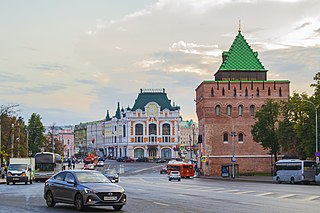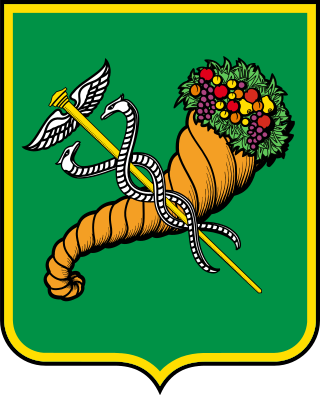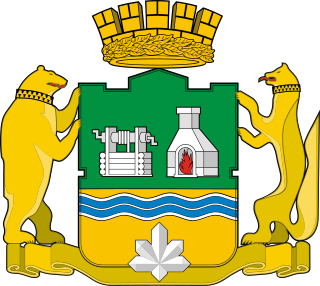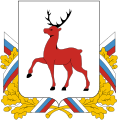
Nizhny Novgorod, colloquially shortened to Nizhny, from the 13th to the 17th century Novgorod of the Lower Land, known from 1932 to 1990 as Gorky, is the administrative centre of Nizhny Novgorod Oblast and the Volga Federal District. The city is located at the confluence of the Oka and the Volga rivers in Central Russia, with a population of over 1.2 million residents, up to roughly 1.7 million residents in the urban agglomeration. Nizhny Novgorod is the sixth-largest city in Russia, the second-most populous city on the Volga, as well as the Volga Federal District. It is an important economic, transportation, scientific, educational and cultural center in Russia and the vast Volga-Vyatka economic region, and is the main center of river tourism in Russia. In the historic part of the city there are many universities, theaters, museums and churches.

The coat of arms of Russia derives from the earlier coat of arms of the Russian Empire. Though modified more than once since the reign of Ivan III (1462–1505), the current coat of arms is directly derived from its medieval original, with the double-headed eagle having Byzantine and earlier antecedents. The general tincture corresponds to the fifteenth-century standard.

The coat of arms of Georgia is one of the national symbols of the republic. It is partially based on the medieval arms of the Georgian royal house and features Saint George, the traditional patron saint of Georgia. In addition to St. George, the original proposal included additional heraldic elements found on the royal seal, such as the seamless robe of Jesus, but this was deemed excessively religious and was not incorporated into the final version.

Strigino Airport is the international airport serving the city of Nizhny Novgorod, Russia. It is located on the outskirts of the city's Avtozavodsky District, 14 km (8.5 mi) southwest of city centre. Strigino is responsible for serving the 3,281,000 residents of the Nizhny Novgorod Oblast.

The Coat of arms of Kharkiv is the official coat of arms of both Kharkiv city and Kharkiv Oblast.

The coat of arms of Kropyvnytskyi is one of the city's symbols reflecting its past and the controversies of its history.
The 2012–13 Volga season was the 2nd season that the club played in the Russian Premier League, the highest tier of football in Russia. They finished the season in 12th place and were eliminated from the Russian Cup at the Round of 32 stage by Russian National Football League side FC Khimki. Manager Dmitri Cheryshev was sacked during pre-season and was replaced by Gadzhi Gadzhiev on 7 June 2012 Gadzhiev then resigned on 19 January 2013 and was replaced by Yuriy Kalitvintsev.

Nizhny Novgorod railway station is a central station in Nizhny Novgorod, Russia. In terms of the amount of work performed, the 1st class station, and by the nature of the work performed, is a cargo station. It was opened on August 2, 1862.

The coat of arms of Saint Petersburg is the official symbol of the city and was adopted in 23 April 2003.

Ivan Karnilin (Russian: Иван Николаевич Карнилин, born 17 January 1957) is a Russia politician. He served as head of Nizhny Novgorod.

Rozhdestvenskaya Street – an historic street in Nizhny Novgorod. Is a unique open-air museum, there are only stone houses, the history of the oldest of which dates back to the middle of the 18th century. Officially there are 35 monuments of architecture. The most famous landmark is the Church of the Nativity.

The Mayor of Nizhny Novgorod is head of the executive branch of the political system in Nizhny Novgorod, the Administration of Nizhny Novgorod. Since May 6, 2020 the position is occupied by Yury Shalabayev.

The Spit of Nizhny Novgorod is one of the main natural landmarks in the historical centre of Nizhny Novgorod. It is located at the confluence of the Oka and Volga rivers.

FC Pari Nizhny Novgorod or FC Pari NN for short is a Russian football club from Nizhny Novgorod, founded in 2015. It made its debut in the Russian Premier League in the 2021–22 season.
Mikhail Sergeevich Kuznetsov is a Russian state, public and scientific figure. He served as Deputy head of Nizhny Novgorod, and deputy of the City Duma of Nizhny Novgorod.

The coat of arms of Sevastopol is a heraldic symbol representing the city of Sevastopol, Crimea. It is featured in the middle of the Flag of Sevastopol on a red background.

Elizaveta Solonchenko is a Russian politician who served as the Head of Nizhny Novgorod (2017), Deputy Head of Nizhny Novgorod (2013–2017), Deputy Chairman of the City Duma of Nizhny Novgorod. She has been critical of the federal government.

Neustroevs-Bashkirov manor house is a architectural ensemble in the downtown Nizhny Novgorod. The main building was founded in the 1806, the building wing was built in the 1902–1903.

The coat of arms of Yekaterinburg is the official municipal coat of arms of Yekaterinburg, Russia. The current symbol was adopted on 23 May 2008 and consists of a French shield divided horizontally into two fields, with a white mine shaft and a white furnace within the top field, which is green, and a blue wavy bend within the bottom field, which is gold. A gold bear and gold sable are located to the left and right of the shield, respectively. A gold crown with a gold laurel wreath is located above the shield and a gold ribbon is located below the shield. A grey druse is located at the bottom center of the shield.
The 2021–22 season was the seventh season in the existence of FC Nizhny Novgorod and the club's first season in the top flight of Russian football. In addition to the domestic league, FC Nizhny Novgorod participated in this season's editions of the Russian Cup, they was eliminated in round of sixteen.































